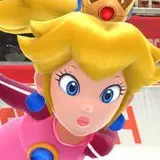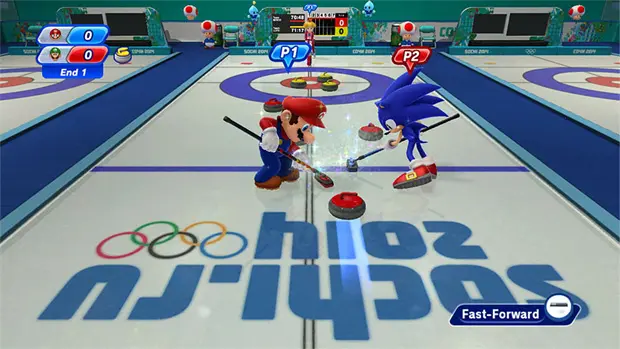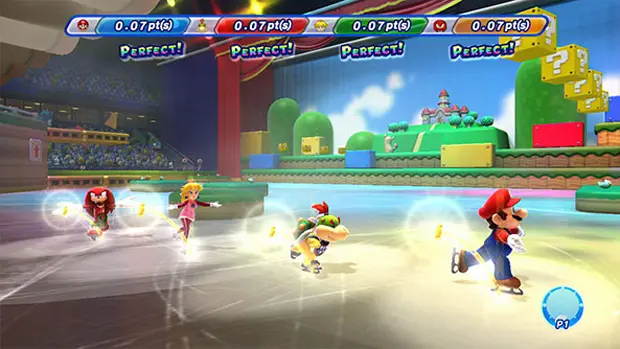 The still unlikely pairing of the Super Mario Bros. and Sonic the Hedgehog franchises under an Olympic banner has carried the torch to the latest Nintendo console, Wii U. The advent of motion controls was the perfect launching platform for the first Mario & Sonic mash-up shortly after the Wii launched. With Mario & Sonic at the Olympic Winter Games Sochi 2014 on Wii U, the reliance on motion controls far outweighs the introduction of the Wii U GamePad to the competitive sports franchise.
The still unlikely pairing of the Super Mario Bros. and Sonic the Hedgehog franchises under an Olympic banner has carried the torch to the latest Nintendo console, Wii U. The advent of motion controls was the perfect launching platform for the first Mario & Sonic mash-up shortly after the Wii launched. With Mario & Sonic at the Olympic Winter Games Sochi 2014 on Wii U, the reliance on motion controls far outweighs the introduction of the Wii U GamePad to the competitive sports franchise.
That’s not to say Sochi 2014 isn’t a fun party game that excels in party situations where multiple players are competing in the same living room. Like its predecessors it does just that, but an opportunity to take creative chances with the Wii U GamePad and asymmetrical gameplay as evidenced in the Wii U launch title Nintendoland is sorely missed.
Following the template of past games in the Mario & Sonic Olympic Games, Sochi 2014 splits the games into two types of events: Olympic Events and Dream Events. The Olympic Events are just that, games modeled after their Olympic counterparts; while the Dream Events are over-the-top exaggerations of Olympic Events that dance into Mario Party territory and ooze with charm.

There are a total of 16 Olympic Events in Sochi 2014 and almost every one of them requires the use of motion controls with either a Wii Remote with Motion Plus, the Wii U GamePad, or in select instances a combination of both. The GamePad is put to use in the four-man bobsled event where it is tilted from side to steer, with the added use of the ZL and ZR buttons to control the movements of your teammates. This event marks the most practical implementation of the GamePad into the game and is one of the better events available.
The other Olympic Events range from ice events like hockey, speed skating and the aforementioned four-man bobsled, and figure skating, and snow events like alpine skiing downhill, snowboard cross, and snowboard slopestyle. There are also some offbeat events like curling and biathlon to help break up the usual suspects.
I had high hopes for hockey and found it fun to play, but also found the skill level of the cpu players to veer toward the unintelligent end. It was far too easy to skate circles around opponents and get clear shots on goal, even though putting the puck into the net was challenging unless the game initiated a slow-motion slapshot sequence that uses the GamePad to “draw” where to shoot the puck. The GamePad use here was neat, but it was almost impossible not to score in this situation.

Unlike say figure skating where it makes logical sense to use the Wii Remote to dictate skating maneuvers, the use of motion controls for other events such as skiing comes across as a tired exercise in fighting the controller to move where you want to. Traditional controls make much more sense for steering, but the game instead falls back upon the tried and tired motion controls that often inadvertently end up sending the skier or snowboarder veering far off course, and ultimately led to a mass abandoning of the Wii as a preferred gaming device.
On one hand the design of the Wii U that relies upon Wii Remotes for multiplayer and the legacy of motion controls from the Wii that comes with it is dictating the recycled design choices on Wii U. On the other, the option to flip a Wii Remote on its side and use traditional controls if desired would have helped alleviate some of the staleness and struggles brought on by the persistent use of motion controls.
The eight Dream Events are where Sochi 2014 manages to break the ice and offer up some truly fun nostalgic gameplay experiences with worlds and music inspired from the franchises powering the game. There’s a bizarre snowball fight that borrows a familiar Super Mario Bros. gameplay element and plays from the third-person perspective, and a figure skating spectacular complete with a “Bowser boss” to defeat in his castle environment. The Bullet Bill sledge race is all kinds of wacky as the bullets replace reindeers in a race to the finish. Nostalgia is a powerful ally in Nintendo first-party games and I felt completely immersed in it traversing from one Dream Event to the next.

Whatever creativity was injected into the Dream Events failed to collide with the character roster that is an exact replica of the previous game. Not a single new character has qualified to participate in the Sochi 2014 games despite new character introductions in the latest Mario and Sonic franchises, respectively. Nintendo often gets a bad rap for its games failing to innovate and evolve, and unfortunately this oversight of shuffling the roster deck to better compliment newer games is more ammunition to fuel that argument.
Online play makes its franchise debut in Sochi 2014 with an irritating caveat: only four events are included. Hockey with its frenetic arcade-play is tailor made to play online but instead the offerings include freestyle ski cross, snowboard cross, short track speed skating, and the four-event mash-up winter sport’s champion race from the Dream Events. The latter is the most robust event offering in the entire game with a selection of snowboarding, ice skating, bobsledding and skiing on the same single course, so it’s good to see that it made the cut for online.
In a party situation with other players, Mario & Sonic at the Olympic Winter Games Sochi 2014 draws out the natural competitive nature in all of us and offers up some good times. As a solo affair for anyone over the age of 10, the honeymoon of initially testing out each event wears off fast and aside from chasing some unlockables, there’s no real pull to keep coming back to what amounts to yet another collection of motion-controlled mini-games.
– Dan Bradley
Mario & Sonic at the Olympic Winter Games Sochi 2014 was reviewed on Wii U using a code provide by publisher Nintendo. It was released exclusively for Wii U on November 15, 2013.



